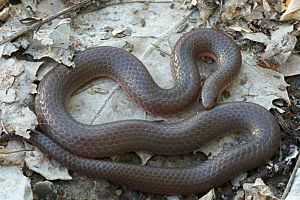Midwestern worm snake facts for kids
Quick facts for kids Midwestern worm snake |
|
|---|---|
 |
|
| Conservation status | |
| Scientific classification |
|
| Kingdom: | Animalia |
| Phylum: | Chordata |
| Class: | Reptilia |
| Order: | Squamata |
| Suborder: | Serpentes |
| Family: | Colubridae |
| Genus: | Carphophis |
| Species: | |
| Subspecies: |
C. a. helenae
|
| Trinomial name | |
| Carphophis amoenus helenae Kennicott, 1859
|
|
| Synonyms | |
|
|
The midwestern worm snake, Carphophis amoenus helenae, is a special kind of snake. It is a subspecies of the eastern worm snake. This snake is not venomous, meaning it's harmless to humans. It belongs to the Colubridae family, which is a very large group of snakes. You can only find this snake in certain parts of the Midwest and Southern United States. It's a unique creature of these regions.
Contents
What's in a Name?
The scientific name for this snake, helenae, has a cool story. It was named after "Miss Helen Tennison." She was a cousin of Robert Kennicott, the person who first described this snake. Helen helped by collecting snake specimens for him in Mississippi.
Other Names for This Snake
People have many different common names for C. a. helenae. Some call it the central twig snake or central worm snake. Other names include ground snake, Helen's snake, Helen Tennison's snake, Helen's worm snake, red snake, and simply worm snake.
Where Do They Live?
The midwestern worm snake, C. a. helenae, lives in a wide area. You can find it from southern Ohio down to northern Georgia in the east. In the west, its home ranges from southern Illinois to eastern Louisiana.
What Do They Look Like?
When fully grown, the midwestern worm snake is small. It looks a lot like a worm. It rarely grows longer than 9.8 in (25 cm) from head to tail. Its top side is a plain dark brown color. Its belly is a light pink.
Special Head Scales
The scales on the front of its head are very unique. Most snakes, even other kinds of worm snakes, have four small scales there. But the midwestern worm snake is different. It has only two large scales instead of four. These two large scales are formed by two pairs of scales that have joined together. This makes it easy to tell this snake apart from others.
How They Live and What They Eat
The midwestern worm snake is a fossorial animal. This means it spends most of its life underground. It loves to burrow in moist soil. You can also find it under piles of fallen leaves. It searches for soft-bodied prey there. Its favorite food is earthworms.
Where They Like to Be
This snake is quite shy and secretive. It prefers to live in moist deciduous forests. These are forests with trees that lose their leaves in the fall. The damp soil and leaf litter in these forests are perfect for burrowing and finding food.


